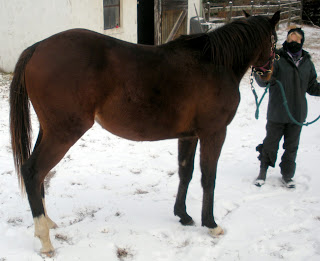Review: Flamingo
Road
by Sasscer Hill
Flamingo Road by Sasscer
Hill is the 1st book in the Fia McKee Mystery series (available April 18,
2017).
Sasscer Hill likes horses,
and not in a “My Little Pony” kind of way. A horsewoman and horse breeder, it’s
in her blood. As she explains on her blog:
I started galloping about the family
farm on a stick horse when I was four years old. By the time, I was seven or
eight, I was sneaking rides on the Belgian plow horses. I did this because my
father didn't like horses and considered ponies dangerous. So instead, I
drummed my heels on the sides of a 2,000-pound draft mare, while grasping
whatever string or rope I managed to tie to her halter.
Her debut mystery series featured a
young female jockey named Nikki Latrelle, and the books were atmospheric tales
that brought the racing world to life more authentically than anyone had
since Dick Francis died. (On her blog, Sasscer pays tribute to
Dick Francis as her favorite author.)
The protagonist
in Flamingo Road, the 1st in the Fia McKee series, is a cop whose
solitary beat in the crime-ridden streets of Baltimore could not be further
from the sunlit racetrack at Florida’s Gulf Stream Park if it was located on
the moon. And yet, by saving the life of a terrified woman named Shyra Darnell,
who works at Pimlico Race Track as a “hot walker,” Fia is thrown into a mystery
that connects her past to her present in a most unexpected way.
Despite being under investigation by
Internal Affairs, Fia can’t help but pick at the mystery surrounding Shyra and
wonder what (or who) she is so afraid of.
Then, a call from her estranged
brother summons her to Florida, bringing her into contact with horse-butchering
lunatics, cutting-edge performance-enhancing drugs, handsome animal activists,
and Cuban gangs. Suddenly, things get very personal when her already troubled
niece loses her beloved gelding Cody.
What was this? Kids
on a joyride? Stealing tack or Patrick’s tools and equipment? Whatever it was,
it wasn’t right.
I sped down the drive, my rubber
shoes silent. The cart had headed to the right on the far side of the stable,
and it looked like the fastest way to catch up would be to run straight down
the center aisle and out the other side. Plunging into the murk of the barn, I
smelled a horrible, familiar odor before skidding in what had to be blood. I
wound up on my hands and knees, staring at a dark lump on the floor.
God, no. “You sons of bitches!” I
yelled. I staggered up, skirted the slick, sticky pool and ran out the back. In
the distance, I heard a couple of thumps. A truck engine started, but no lights
came on. The sound of a motor rapidly faded into the distance.
Feeling helpless and sickened, I
searched for a light switch and found it. Okay, Fia, get a grip. I
flipped the switch.
Blood was
everywhere. Cody’s black tail like a paintbrush dipped in blood looked. I
fought a wave of nausea. They had butchered him in his own barn, removing the
large cuts of meat. I wanted to kill them. I grabbed my phone and called 911.
Fia, whose horse-trainer father was
murdered in a case as cold as Maryland in winter, knows this horsey world very
well. And thanks to Hill, who teaches classes on how to craft settings that
“saturate a story with mood, meaning, and thematic connotations,” we are
immersed in that world as well. (Maybe a little too well as we
learn the particulars of the trade in horse meat.)
“Your horse,” Zanin
said, “was butchered by Cuban Americans who live in the C-Nine Basin. By now,
they’ve delivered his meat to a specialty butcher shop in Miami.”
Patrick shook his head as if denying
the whole thing. “That’s disgusting. It doesn’t make sense. There can’t be
enough money to outweigh the risk.”
“I’m betting the horse was young,”
Zanin said. “Maybe a little fat?”
Recalling Jilly’s conversation at
dinner, I said, “Cody was only three.” An image struck me. Cody plump and happy
in the paddock with Jilly that afternoon. “Oh, God. He was fat. Is that why
they killed him?”
“Yeah,” Zanin said. “They like ’em
young and well-marbled. Brings the highest price, like beef.”
I dropped my head into my hands. It
was impossible to shut out the images. Glancing at him, I said, “Who are these
people? And what’s the C-Nine Basin?”
“It’s the Wild West of Florida.
Straddles the western edge of Broward and Miami-Dade counties, along one side
of the Everglades. Mostly men live there, Cubans and Haitians and almost
everything they do is outside the law—cockfights, horse slaughter, dogfights.”
“But Patrick’s right,” I said. “It
doesn’t make sense. Horse slaughter is legal in so many places now.”
Zanin gazed at me intently. “Think
about it.”
I cringed as it hit me. “It doesn’t
matter if it’s legal because if those animals are old and tough…”
Zanin nodded. “They
bring less money. The men in the C-Nine, they’re renegades, squatters, really
rough people. These guys build shacks and pilfer from electric lines. They
don’t care about right and wrong, especially when money in the form of prime
meat is available just down the road. Believe me, the police are afraid to go
in there.”
Turns out, there’s a really good
reason the cops are scared to go into the C-Nine, and before the story gallops
to a conclusion (sorry), readers will be scared too. And they’ll know a lot
more about the racing world than they did before they opened the book.
Click here to find FLAMINGO ROAD!
Katherine Tomlinson is a former
reporter who prefers making things up. She was editor of Astonishing
Adventures Magazine and the publisher of Dark Valentine
Magazine.














